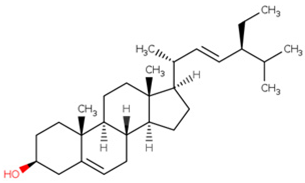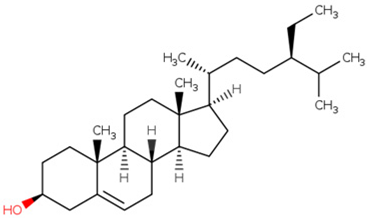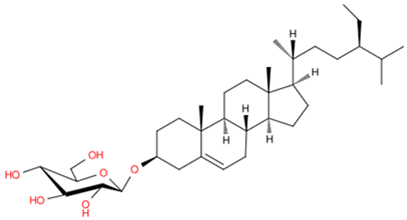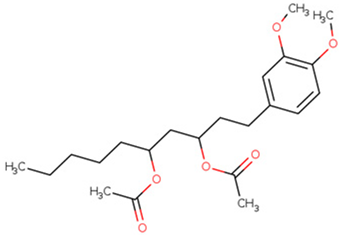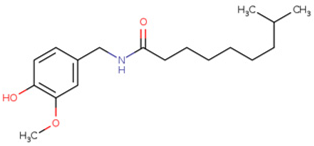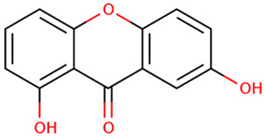Abstract
Colorectal cancer cases are on the rise and have become a leading cause of cancer-related deaths. Ginger (Zingiber officinale) is widely used in traditional herbal medicine and has been proposed as a potential treatment for colorectal cancer. This study aimed to explore the network pharmacology and pharmacodynamics of ginger in colorectal cancer treatment. Colorectal cancer patient data from the GEO dataset were analyzed to identify differentially expressed genes (DEGs). Six key components of ginger were selected based on specific criteria, and their target proteins were predicted using the TCMSP database. By overlapping DEGs with predicted targets, 36 candidate drug targets were identified. These targets were analyzed for biological alterations, pathway enrichment, protein–protein interactions, and hub-gene selection, integrating network pharmacology. Molecular docking simulations were conducted to confirm the binding interactions between ginger components and target proteins. The findings showed that GABAergic signaling and apoptosis were the most enriched pathways, suggesting their potential role in colorectal cancer treatment. Docking simulations further revealed that ginger’s active compounds bind to COX2 and ESR1, indicating anti-inflammatory effects and modulation of estrogenic activity. This study provides insight into the systemic mechanisms of ginger in colorectal cancer treatment through an integrated “drug–gene–pathway–disease” network approach.
1. Introduction
Colorectal cancer (CC) is a malignancy of the gastrointestinal tract that originates in the mucosal epithelium of the colon [1]. In recent years, its incidence has been rising, with a particularly rapid increase among younger individuals [2]. According to previous reports, colorectal cancer accounts for approximately 10.2% of all cancer cases and 9.2% of cancer-related deaths worldwide, ranking as the second most common cancer in terms of both incidence and mortality [3]. The development of colorectal cancer is a multifactorial process influenced by a combination of genetic alterations, lifestyle-related risk factors, environmental chemical exposures, and chronic inflammation, and symptoms often do not appear until the disease has reached an advanced stage. Common symptoms include constipation, intestinal obstruction, abdominal pain, weight loss, bloody stools, and lymphatic metastasis [4]. Current treatments primarily involve chemotherapy, surgery, and biologic drug therapy [5]. Additionally, adjuvant therapies such as oxaliplatin, capecitabine, and fluorouracil are frequently used. However, these treatments come with significant side effects, including neuropathy, neutropenia, diarrhea, and drug resistance [6]. Given these limitations, there is a pressing need to develop more effective and safer therapeutic options for colorectal cancer that minimize complications and adverse effects.
Throughout history, medicinal plants have been widely used as either alternatives or complementary treatments to conventional therapies in many countries. Herbal medicines, which have been practiced for over a thousand years, are particularly well-established in Asian countries, especially China [7]. Their multiple-component, multiple-target, and multiple-pathway properties make them a valuable natural source for anticancer agents, with more than half of therapeutic drugs being derived from them [8]. Traditional Chinese Medicine (TCM) has long played a pivotal role in the prevention and treatment of a wide range of diseases, integrating holistic principles with diverse therapeutic modalities [9]. In cancer treatment, prolonged exposure to chemo-radiotherapy often leads to adverse effects such as immunosuppression, organ and cellular damage, gastrointestinal irritation, and cumulative neuropathy, all of which can significantly impact a patient’s quality of life. Additionally, therapeutic resistance is a major challenge in chemoradiotherapy [10]. Medicinal plant-based treatments offer a promising approach to mitigating these complications.
Ginger (Zingiber officinale Roscoe) has been widely utilized in Traditional Chinese Medicine (TCM) for centuries. It is predominantly cultivated in Nigeria, India, and China [11]. The rhizome of ginger contains various bioactive compounds, including volatile oils, diarylheptanoids, phenolic compounds, and phenyl alkaloids, which contribute to diverse pharmacological properties [12]. However, the precise molecular mechanisms through which the bioactive components of ginger exert their anticancer effects remain insufficiently understood.
Network pharmacology is an advanced approach that integrates computational biology, bioinformatics, and network science with pharmacological methodologies to explore the molecular regulatory mechanisms of Traditional Chinese Medicines (TCMs) [13]. This approach aligns with the holistic perspective of TCM, utilizing the principle of precise and individualized treatment, thereby enhancing scientific research and therapeutic effectiveness in modern pharmacology [14]. The aim of this study was to identify the bioactive compounds in ginger using network pharmacology, determine key target compounds for colorectal cancer treatment, explore their potential mechanisms of action, and provide a foundation for the development and clinical application of ginger-based therapies.
2. Materials and Methods
2.1. CC Cohort Data Collection and Acquisition
Colorectal cancer (CC) gene expression datasets, GSE41258 and GSE44076, were retrieved from the Gene Expression Omnibus (GEO) database NCBI (http://www.ncbi.nlm.nih.gov/geo/) (accessed on 9 June 2024), a publicly available repository for gene expression, sequencing, and microarray data. The GSE41258 dataset (GPL96 [HG-U133A] Affymetrix Human Genome U133A Array, Israel) includes gene expression profiles from 98 normal and 98 cancerous tissue samples [15]. Similarly, the GSE44076 dataset (GPL13667 [HG-U219] Affymetrix Human Genome U219 Array, Spain) consists of gene expression data from 54 normal and 186 cancerous tissue samples [16].
2.2. Gene Expression Analysis and DEGs Identification
A total of 284 tumor samples and 152 non-tumor tissue samples were analyzed. The differentially expressed genes (DEGs) between colorectal cancer and non-cancerous samples were identified by using R programming through the online platform Imageo (https://imageo.genyo.es/) (accessed on 11 June 2024) [17]. Imageo is a web-based tool designed to compare multiple datasets within the GEO series to identify DEGs. Additionally, the platform was used to calculate p-values and |logFC|values, with the cutoff criteria for DEG identification set at p < 0.05 and |logFC| ≥ 1.0.
2.3. Ginger Chemical Components and Target Selection
The Traditional Chinese Medicine Systems Pharmacology (TCMSP) database (https://ngdc.cncb.ac.cn/databasecommons/database/id/4096) (accessed on 9 June 2024) is a freely accessible database that includes numerous components from herbal medicines, along with associated targets and pharmacokinetic data [7]. To investigate the potential active components of ginger (Zingiber officinale), compounds were filtered based on oral bioavailability (OB) ≥ 30% and drug-likeness (DL) ≥ 0.18. The protein targets with these active compounds were then predicted using both the TCMSP and Swiss Target Prediction databases (http://www.swisstargetprediction.ch/) (accessed on 9 June 2024) [18].
2.4. DEGs Overlapping of CC and Ginger Targets Using Venn Diagrams
The DEGs of CC and Ginger (Zingiber officinale) were compared using Venny (2.0.1), to automatically search for intersection genes and draw Venn diagrams (https://bioinfogp.cnb.csic.es/tools/venny/) (accessed on 9 June 2024).
2.5. Biological Function and Pathway Analysis
The overlapping of differentially expressed genes (DEGs) was analyzed by using the DAVID database (https://davidbioinformatics.nih.gov/tools.jsp) (accessed on 9 June 2024) [19]. The statistical threshold was set at p < 0.05, and the analysis was conducted using Gene Ontology (GO) and Kyoto Encyclopedia of Genes and Genomes (KEGG) enrichment methods [20].
2.6. Modular Clustering Analysis
To categorize biological functions, the PPI network was implied to the MCODE linked in Cytoscape 3.8.2 [21]. The MCODE algorithm was used to identify tightly connected protein clusters within a large target network, and the terms of biological functions of each module were subsequently annotated.
2.7. Protein–Protein Network Construction and Hub-Gene Selection
Intersecting differentially expressed genes (DEGs) were input into the STRING database, with Homo sapiens selected as the species. A high-confidence interaction threshold of 0.4 was applied, and unconnected proteins were excluded. The resulting protein–protein interaction (PPI) network data were imported into Cytoscape 3.8.2 for visualization. Degree and centrality metrics for each node were calculated using Network Analysis, and genes with values equal to or greater than twice the median were identified as hub genes.
2.8. Network Construction of Ginger-Component Target Interactions
Taking CC, ginger, and overlapping genes as the research objects, a component–target, gene–disease, and shared pathways network was constructed by using Cytoscape 3.8.2.
2.9. Verification by Molecular Docking Simulation
The two-dimensional structures of ginger’s components were retrieved from PubChem and saved in mol2 format (https://pubchem.ncbi.nlm.nih.gov/) (accessed on 11 June 2024). The candidate proteins from the PPI network were obtained from the PDB database (https://www.rcsb.org/). Both the chemical structure and protein files were uploaded to the SWISSDOCK database [22]. ChimeraX version 1.4 was used to visualize the binding between the chemical and protein, and the binding energy was calculated to assess the ligand–protein interaction.
3. Results
3.1. Screening and Collection of Ginger Target Genes
A total six putative compounds, including Euxanthone (MOL003358), Dihydrocapsaicin (MOL008698), 6-Methylgingediacetate (MOL006129), poriferast-5-en-3beta-yl beta-D-glucopyranoside (MOL001771), beta-sitosterol (MOL000358) and Stigmasterol (MOL000449), meeting the criteria of OB ≥ 30% and DL ≥ 0.18, were screened from the TCMSP database as shown in Table 1 and their genes target are shown in Table 2.

Table 1.
The putative component of ginger (Zingiber officinale).

Table 2.
A list of protein targets that interact with selected ginger components.
3.2. Identification of DEGs in CC
The analysis of the GEO database, composed of the GSE41258 and GSE44076 datasets, identified 7587 DEGs based on the cutoff criteria. A volcano map and distribution clustering heatmap of the identified DEGs are shown in Figure 1. The overall top 100 clustering heatmap of significant DEGs is shown in Figure 2. In addition, a total of 36 intersection DEGs among colorectal cancer and ginger target genes were retrieved for further mechanistic investigations of ginger in the treatment of colorectal cancer (Figure 3).
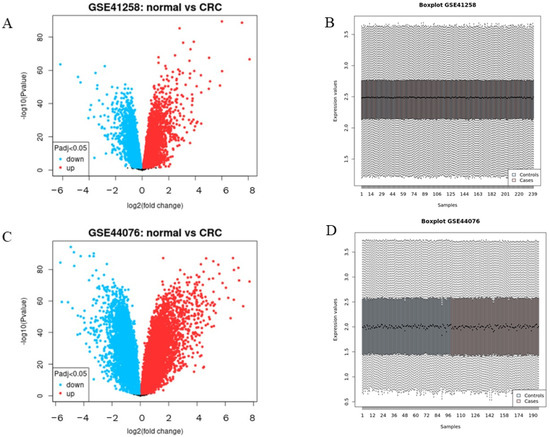
Figure 1.
Bioinformatics analysis of colon cancer patients from GSE41258 and GSE44076. (A,C) Differentially Expressed Genes (DEGs) were clustered between colorectal cancer and normal tissue from colorectal patients as shown in the volcano plot. The blue and red dots represent down- and up-regulated genes, respectively. (B,D) A normalization of data pairs of healthy normal subjects and patients with colorectal cancer.
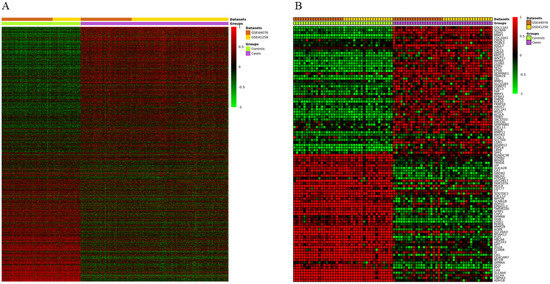
Figure 2.
Hierarchical clustering heatmap of the overall (A) and top one hundred (B) DEGs between colorectal cancer and normal samples in GSE41258 and GSE44076. Each row represents a DEG and each column represents a different sample.
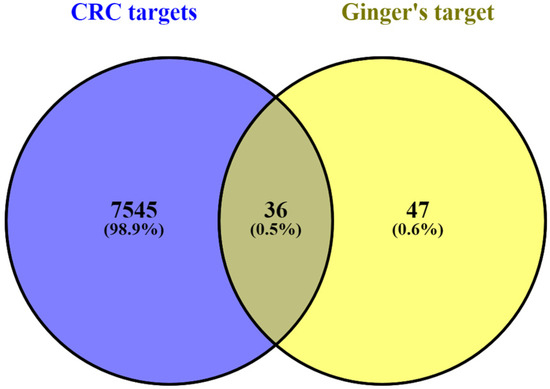
Figure 3.
Venn diagram showing that 0.5% of the genes regulated by ginger are related to colorectal cancer.
3.3. PPI Network Analysis and Hub Gene Selection
The 36 overlapping DEGs were used to construct the PPI network by using Cytoscape software, which includes 36 nodes, 92 edges, while 3 isolated target genes were removed. Hub genes were selected as key targets of ginger for colorectal cancer based on a higher value of the degree of betweenness and closeness. The five hub genes were TP53 (Tumor Protein 53), ESR1 (Estrogen Receptor 1), CASP9 (caspase 9), MMP9 (Matrix metallopeptidase 9), and PTGS2 (Prostaglandin-endoperoxide synthase), as shown in Figure 4.
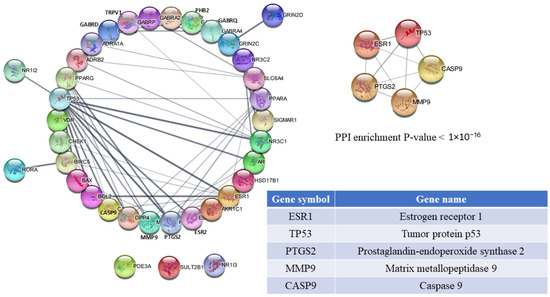
Figure 4.
Protein–protein interaction (PPI) network and hub-gene selection. Five hub genes were selected, including ESR1, TP53, PTGS2, MMP9, and CASP9; the p-value of the protein network is less than 1.0 × 10−16. Full names of the five selected hub genes.
3.4. Gene Ontology Enrichment Analysis
To determine the biological function alterations of ginger targets in colorectal cancer, the terms of biological process were obtained by using the DAVID database. As shown in Figure 5, ten enriched terms of BP are shown, with “transcription initiation from RNA polymerase II promoter” significantly enriched. For cellular components, the term “GABA-A receptor complex” was the most significantly enriched. Finally, the molecular function showed that “nuclear receptor activity” and “ligand-activated transcription factor activity” were significantly enriched.

Figure 5.
The dot plot shows the results of gene ontology analysis of ginger’s target genes related to colorectal cancer composed of (A) biological process (BP), (B) cellular component (CC) and (C) molecular function (MF). The size and color are determined by the number of associated genes and their p-values, respectively.
3.5. KEGG Pathway Analysis
KEGG pathway analysis showed how ginger acts on the pathways that have an important role in colorectal cancer. Here, nicotine addiction (hsa05033), glutamatergic synapse (hsa04724), and alanine, aspartate, and glutamate metabolism (has00250), were the top three most significantly enriched pathways as shown in Figure 6.
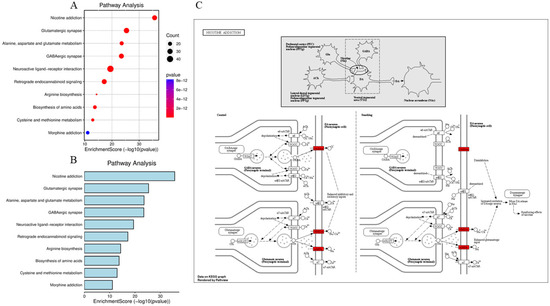
Figure 6.
KEGG pathway enrichment analysis. (A) A dot plot of enriched pathways, the size and color revealed the number of associated genes and their p-values, respectively. (B) A bar chart of pathway enrichment. (C) The most significant enriched pathway from the KEGG analysis was nicotine addiction (GABAergic signaling).
3.6. Transcription Factors (TFs) Analysis
The transcription factor enrichment analysis showed the top 20 transcription factors as shown in Figure 7. STAT3, SP1, and TFAP2A were the top three transcription factors associated with the Ginger response as well as colorectal cancer.
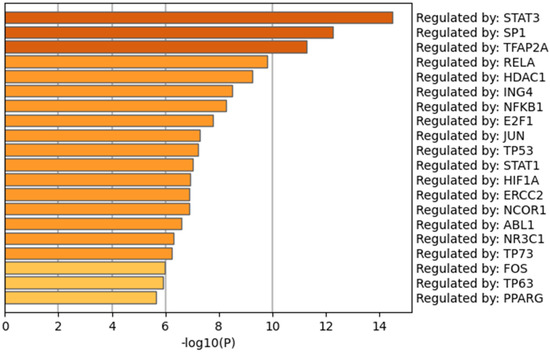
Figure 7.
A bar chart showing the results of Transcription factor (TF) enrichment analysis. The length and color of each bar represent the −log10 of the p-value and the degree of enrichment, respectively.
3.7. Module-Based Network Analysis
MCODE analysis revealed that the differentially expressed genes (DEGs) were grouped into three distinct modules. Module 1 consisted of six genes: GABRP, GABRD, GABRQ, GABRA2, GABRG2, and GABRA4. Module 2 included five genes: ER, ESR1, NR3C1, NR1I2, and PPARG. Module 3 comprised three genes: TP53, BCL2, and BAX. (Figure 8A and Table 3).
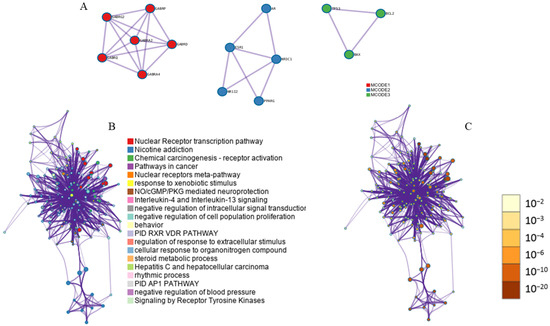
Figure 8.
MCODE (Molecular Complex Detection) enrichment analysis by Metascape. (A) PPI network MCODE component. (B,C) GO enrichment analysis was implied to each MCODE network to assign “meanings” to the network component. The shedding of orange color represents the significant p-value.

Table 3.
The details of the MCODE clustering are shown in the table.
We also performed enriched biological pathways analysis to investigate the relationships among biological pathways or processes. The enriched terms were presented in a network. Each set of terms was represented by a unique color, and the significant terms were ranked by coloring intensity as shown in Figure 8B,C.
3.8. Construction of Putative Components-Targets-Pathways-Diseases
A total of six active components were identified from ginger. Subsequently, 6 active compounds, 39 key targets, and associated enriched pathways—those involving the highest number of genes—were selected to construct an active compound–target gene-associated pathway–colorectal cancer network, as illustrated in Figure 9. The network revealed that a single gene target could be associated with multiple compounds, and conversely, one active compound could interact with multiple targets. Additionally, the network highlighted pathways potentially linking ginger’s active components to colorectal cancer, including the vitamin D-sensitive calcium signaling pathway implicated in depression, NO/cGMP/PKG mediated neuroprotection, mBDNF and proBDNF regulation of GABA neurotransmission, nuclear receptors in lipid metabolism and toxicity, nuclear receptors, GABA receptor, the effect of the intestinal microbiome on the anticoagulant response of vitamin K antagonists, nuclear receptor meta-pathway, chromosomal and microsatellite instability in colorectal cancer, and integrated cancer pathway.
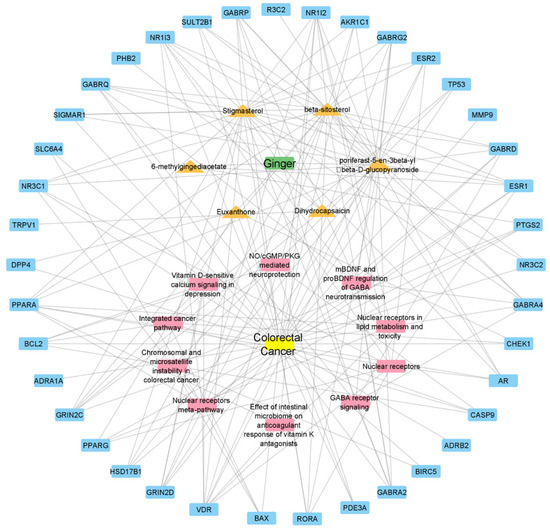
Figure 9.
The regulatory network of ginger’s components–genes–pathways–disease. The yellow represents disease, the pink represents pathways, the blue represents genes, the green represents herbal medicine, and the orange triangle represents components.
3.9. Validation Using Molecular Docking Analysis
To verify the interrelationship among the bioactive compounds of ginger and the protein targets, which were selected by hub genes. We performed molecular docking between the top five protein targets, including ESR1, CASP9, PTGS2, MMP9, and TP53, and the selected six active components from ginger by using SwissDock.
According to the protein–protein interaction network, we selected five hub genes, including CASP9, MMP9, PTGS2, ESR1, and TP53, for molecular docking with selected putative components. ESR1 was predicted to bind to Euxanthone, Dihydrocapsaicin, Methyl diacetoxy-6-gingerdiol, poriferast-5-en-3beta-yl beta-D glucopyranoside, beta-sitosterol, and Stigmasterol, while PTGS2 and COX2 were predicted to bind to 6-Gingediacetate and Dihydrocapsaicin. From molecular docking analyses, the binding energies of the target proteins and the putative ligand compounds were set as <5 kcal/mol, indicating a good binding activity [23]. The predicted binding energies between the putative ligands and their respective target proteins are shown in Figure 10 and Table 4.
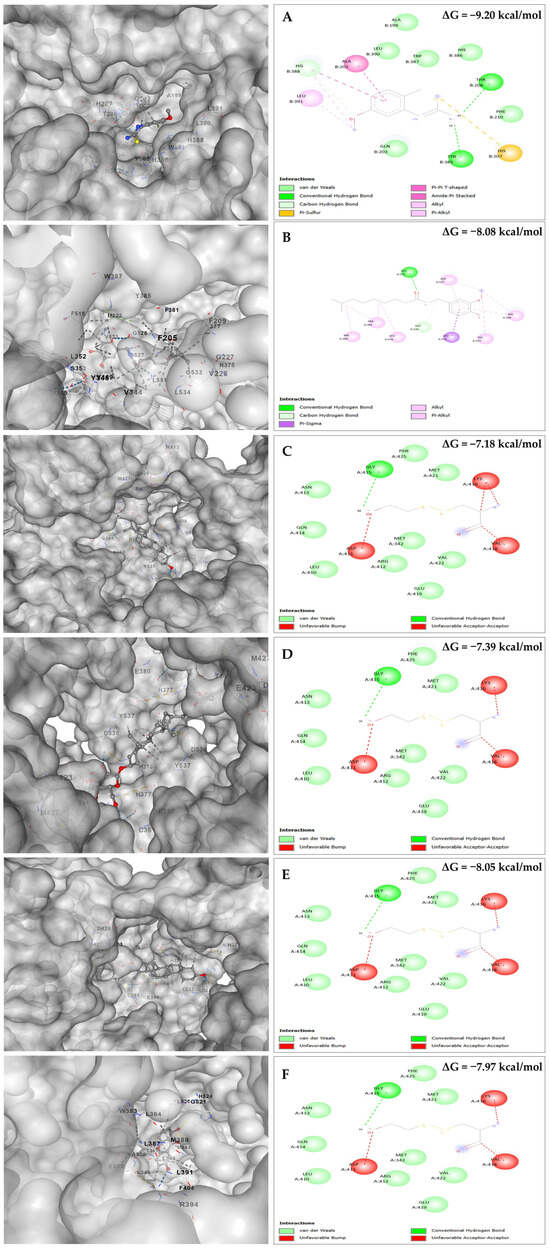
Figure 10.
Molecular docking of PTGS2(COX2) and ESR1 with selected ginger component compounds and their binding affinities (ΔG). (A) High-resolution of COX2 and Methyl diacetoxy-6-gingerdiol with key residues: Leu391 (π-bond), His388 (π-bond and H-bond), Ala202 (π-bond), Thr206 (H-bond), His207 (π-sulfide bond) and Tyr385 (H-bond) in the active site. (B) High-resolution of COX2 and Dihydrocapsaicin with key residues: Phe209 (π-bond), Phe381 (π-bond), Leu534 (π-bond), Leu352 (π-bond), Val523 (π-bond), Val349 (π-bond), Ala527 (π-bond) and Leu531 (H-bond) in the active site. (C) High-resolution of ESR1 and β-sitosterol with key residues: Asp411 (H-bond), Val418 (H-bond), Lys416 (H-bond) and Gly415 (H-bond) in the active site. (D) High-resolution of ESR1 and stigmasterol with key residues: Asp411 (H-bond), Val418 (H-bond), Lys416 (H-bond) and Gly415 (H-bond) in the active site. (E) High-resolution of ESR1 and poriferast-5-en-3beta-yl beta-D glucopyranoside with key residues: Asp411 (H-bond), Val418 (H-bond), Lys416 (H-bond) and Gly415 (H-bond) in the active site. (F) High-resolution of ESR1 and Euxanthone with key residues: Asp411 (H-bond), Val418 (H-bond), Lys416 (H-bond) and Gly415 (H-bond) in the active site.

Table 4.
The table shows the binding affinity values from molecular docking simulations between selected ginger components and target proteins. The bold numbers reveal the highest binding affinity values among the components and targets.
4. Discussion
Colorectal cancer is a malignancy that can develop in any part of the colon or rectum, with a predilection for the distal segments such as the sigmoid colon. Its pathogenesis is complex [24]. Risk factors for the disease include alcohol and red meat consumption, smoking, and a family history of colorectal cancer [25]. Due to concerns about the adverse health effects and resistance to current anti-cancer treatments, researchers are exploring new alternative treatment strategies for colorectal cancer [26]. This study highlights the advantages of Traditional Chinese Medicine (TCM) in cancer treatment, such as its high efficiency from the combination of multiple components and fewer side effects. While individual TCM components have shown effectiveness in cancer treatment, research on these components remains limited [27]. The present study demonstrates that ginger can treat colorectal cancer by targeting multiple pathways through its various bioactive components.
In modern pharmacology, biomedical research is increasingly relying on computational technology and tools such as systems biology, network science, and bioinformatics [28,29]. Network pharmacology allows for the analysis of molecular interactions between therapeutic agents and protein targets, providing insights into the systemic pharmacological mechanisms of drugs from a holistic perspective and illustrating biological interaction networks [30]. The ability of network pharmacology to conduct multi-component and multi-target analyses makes it well-suited for studying the complex mixtures of bioactive compounds found in Traditional Chinese Medicine (TCM) [31]. As a result, this study explored the mechanisms by which ginger (GG) could be used to treat colorectal cancer.
Based on the compound–target–pathway–disease interaction network, the pharmacological effects of ginger on colorectal cancer appear to involve GABA signaling, lipid metabolism, vitamin D and K signaling, neuroprotection, and various cancer-related pathways. In this study, β-sitosterol and stigmasterol were identified as potential therapeutic agents for colorectal cancer. These key plant-derived phytosterols have been reported to inhibit the growth of HT116 and COLO 320DM colon cancer cells [32,33]. β-Sitosterol, in particular, has demonstrated the ability to decrease tumor growth and metastasis in multiple cancer types, including lung and colorectal cancers [34,35], with its effects associated with the induction of Bax expression and caspase activation [36]. These findings suggest that ginger-derived compounds, including β-sitosterol and stigmasterol, may serve as a promising candidate for further investigation and could be developed as therapeutic agents for colorectal cancer.
In this study, a total of 36 key genes were identified as the most significant potential targets for colorectal cancer treatment. These targets were analyzed by using Metascape for gene ontology (GO) and pathway enrichment, revealing several critical pathways that may be regulated by the active components of ginger. Notably, the ‘nicotine addiction’ pathway—particularly involving GABAergic synapses—emerged consistently across both enrichment and module analyses. Gamma-aminobutyric acid (GABA), a major inhibitory neurotransmitter in the central nervous system, has been extensively studied for its roles in neuronal function, neuropathic pain, and neuroinflammation [37]. However, the role of GABA receptors (particularly GABABR) in cancer biology has gained increasing attention [38]. Numerous studies have reported elevated expression levels of GAD, GABA, and GABA receptors in various cancers, including colorectal, lung, and gastric cancers, compared to normal tissues [39]. The binding of GABA to its receptors—GABAA and GABAB—has been shown to influence cancer cell proliferation and invasion, presenting opportunities for the development of receptor-specific agonists and antagonists as potential cancer therapies [40]. Ginger compounds have been reported to modulate glutamine–glutamate–GABA metabolism by decreasing glutamate levels, enhancing GABA synthesis, and increasing GABA concentrations in the hippocampus and frontal cortex [41,42]. In addition to the present findings, ginger’s components may also prevent the suppression of GABA receptor function by inhibiting eicosanoid pathways. Collectively, these observations suggest that ginger and its bioactive constituents could serve as promising candidates, either alone or in combination, for colorectal cancer treatment by targeting GABAergic signaling.
The nicotine addiction pathway and GABAergic signaling are functionally interconnected in the pathogenesis of colorectal cancer. Nicotine-mediated activation of nicotinic acetylcholine receptor (nAChRs) triggers multiple oncogenic signaling cascades, promoting cell proliferation, angiogenesis, and resistance to apoptosis [43,44]. Concurrently, chronic nicotine exposure can downregulate glutamate decarboxylase expression and disrupt GABA receptor signaling, effectively bypassing the inhibitory effects of gamma-aminobutyric acid (GABA) on tumor cell proliferation and migration [45,46]. This dual action shifts the cellular balance toward a pro-tumorigenic state characterized by enhanced survival and invasive capacity of colon cancer cells. Therapeutically, modulation of the GABAergic pathway represents a promising strategy for intervention. Pharmacological activation of GABA receptors or enhancement of endogenous GABA synthesis has demonstrated the potential to counteract nicotine-induced tumorigenic signaling and suppress cancer cell growth in preclinical studies [47,48]. Therefore, targeting GABAergic signaling may provide a novel adjuvant approach for chemoprevention and treatment of nicotine-associated colorectal cancer.
In the transcription factor (TF) analysis, STAT3 emerged as the most significantly enriched transcription factor, potentially playing a crucial role in targeting colorectal cancer. Signal transducer and activator of transcription 3 (STAT3) regulates antitumor immune responses and functions as a central hub for multiple tumorigenic signaling pathways [49]. It is also highly activated in colorectal cancer (CRC), promoting cancer cell migration, invasion, and proliferation [50]. Previous studies have shown that 6-Shogaol from dried ginger inhibited the ovarian cancer (A2780) cell line through STAT3 and induced cell apoptosis in breast cancer cells, possibly through a mechanism involving the Notch signaling pathway [51,52]. Notably, STAT3 could serve as another potential therapeutic target for colorectal cancer treatment.
Module analysis revealed interactions among TP53, BCL2, and BAX, key regulators of the apoptotic process. Ginger and its bioactive compounds have been shown to exert diverse biological effects, including antioxidant, anticancer, hepatoprotective, and anti-inflammatory activities [53]. Previous studies have reported that ginger induces apoptosis in human colorectal cancer cells via the activation of caspases (cysteine-aspartic proteases) and the generation of reactive oxygen species (ROS) [54]. However, the anticancer effects of ginger’s components on other gastrointestinal cancers, such as duodenal, esophageal, anal, GI carcinoid tumors, and pancreatic cancer, have not yet been fully established and require further investigation.
Docking simulation results indicated that ginger’s components can bind to COX2 and ESR1 proteins. Cyclooxygenase2 (COX2) is a prostaglandin-endoperoxide synthase 2, encoded by the PTGS2 gene in humans, that plays a crucial role in converting arachidonic acid to prostaglandins [55]. This enzyme is especially important during inflammatory responses and in the progression of various pathological conditions. Previous studies presented that COX2 overexpression is linked to various gastrointestinal cancers, including gastric, pancreatic, liver, esophageal, and colorectal cancers [56]. Inflammation is a major risk factor for colorectal cancers, and COX2 overexpression is closely linked to its development. Investigating the role of COX2 and its inhibition as a prognostic biomarker for early detection and prevention is essential [57]. Additionally, ginger has been shown to have anti-inflammatory effects by modulating the immune response during the cellular phase [58]. Another notable property of ginger extract is its antinociceptive effects induced by acetic acid [59]. Its bioactive compounds exhibit analgesic and anti-inflammatory effects through COX2 inhibition, thereby preventing arachidonic acid metabolism [60]. The therapeutic effects of ginger resemble those of nonsteroidal anti-inflammatory drugs (NSAIDs); however, ginger is beneficial for the stomach as it does not negatively affect the stomach mucosa, thus preventing gastritis [61]. Currently, ginger’s components are also recognized for their biological activities, such as anti-allergic, antioxidant, and antimicrobial properties, as well as their role in cancer prevention [62].
Estrogen receptor 1 (ESR1) is a member of the nuclear receptor subfamily 3, group A, which encodes one of the two principal estrogen receptors (ERs) and is activated by estrogen [63]. ESR1 expression is typically low in both normal and malignant colonocytes; several studies have demonstrated that elevated ESR1 levels correlate with unfavorable clinical outcomes in colorectal cancer (CRC) patients [64]. Moreover, accumulating evidence indicates that ESR1 may contribute significantly to the development and progression of colorectal cancer (CRC) [65]. Recent findings have shown that (10)-gingerol, a bioactive constituent of ginger, exhibits greater efficacy than (6)-gingerol in inhibiting the proliferation of human and murine mammary carcinoma cells [66]. Further investigations demonstrated that (10)-gingerol effectively suppresses the proliferation of breast cancer cells that are estrogen receptor-positive and exhibit HER2 overexpression [67]. Despite these promising results, the specific impact of ginger’s bioactive constituents on estrogen-mediated signaling pathways in colorectal cancer remains to be elucidated and warrants further investigation.
These findings suggest that the anticancer effects of ginger are mediated by the regulation of multiple targets through various components. However, a more comprehensive understanding of the molecular mechanisms by which ginger inhibits the formation and growth of colorectal cancer is still needed. Additionally, this study primarily focused on the lipid components of ginger and did not include larger molecular compounds such as polysaccharides and amino acids, which should be explored in future research. Lastly, since the etiology of colorectal cancer differs between Western and Asian countries, further studies should delve deeper into the pathological mechanisms specific to colorectal cancer.
5. Conclusions
In conclusion, six bioactive components from ginger were identified, along with 36 related disease targets for the treatment of colorectal cancer. The PPI network analysis led to the selection of 36 candidate targets for hub gene identification. The enriched signaling pathways highlighted the significant role of GABAergic signaling in the mechanism through which ginger mediates colorectal cancer treatment. Additionally, TP53, BCL2, and BAX were identified as the key target proteins for ginger in combating colorectal cancer. These findings will be valuable in identifying lead compounds for the development of new treatments for colorectal cancer. Although bioinformatics-based network pharmacology and molecular docking analyses offer valuable preliminary insights into the potential targets and mechanistic pathways of Zingiber officinale in colorectal cancer, these approaches possess inherent limitations. Their predictive nature depends largely on the quality, accuracy, and completeness of existing databases and algorithms, which may not fully reflect the dynamic complexity of in vivo biological systems. Furthermore, computational docking does not account for critical factors such as bioavailability, metabolism, pharmacokinetics, or the influence of the tumor microenvironment, thereby necessitating subsequent experimental validation to confirm the biological relevance of the predicted interactions.
Author Contributions
S.C. and J.S.: Conceptualization, Methodology, Software. S.C.: Data curation, Writing—Original draft preparation. N.V.: Visualization, Investigation, Validation. J.S.: Supervision. All authors: Writing—Reviewing and Editing. All authors have read and agreed to the published version of the manuscript.
Funding
This work was supported by Thailand Science Research and Innovation (TSRI), Chulabhorn Research Institute (CRI) (Grant No.49891/4759802).
Institutional Review Board Statement
Not applicable.
Informed Consent Statement
Not applicable.
Data Availability Statement
The data presented in this study are available upon the request from the corresponding author.
Acknowledgments
We sincerely thank James M. Dubbs, senior research scientist at the Chulabhorn Research Institute (CRI), for proofreading the manuscript.
Conflicts of Interest
The authors declare there is no potential conflicts of interest.
References
- Alzahrani, S.M.; Al Doghaither, H.A.; Al-Ghafari, A.B. General Insight into Cancer: An Overview of Colorectal Cancer. Mol. Clin. Oncol. 2021, 15, 271. [Google Scholar] [CrossRef]
- Sifaki-Pistolla, D.; Poimenaki, V.; Fotopoulou, I.; Saloustros, E.; Mavroudis, D.; Vamvakas, L.; Lionis, C. Significant Rise of Colorectal Cancer Incidence in Younger Adults and Strong Determinants: 30 Years Longitudinal Differences between Under and Over 50s. Cancers 2022, 14, 4799. [Google Scholar] [CrossRef] [PubMed]
- Didkowska, J.; Wojciechowska, U.; Michalek, I.M.; Caetano dos Santos, F.L. Cancer Incidence and Mortality in Poland in 2019. Sci. Rep. 2022, 12, 10875. [Google Scholar] [CrossRef]
- Winner, M.; Mooney, S.J.; Hershman, D.L.; Feingold, D.L.; Allendorf, J.D.; Wright, J.D.; Neugut, A.I.M. Management and Outcomes of Bowel Obstruction in Patients with Stage IV Colon Cancer: A Population-Based Cohort Study. Dis. Colon Rectum 2013, 56, 834–843. [Google Scholar] [CrossRef] [PubMed]
- Mishra, J.; Drummond, J.; Quazi, S.H.; Karanki, S.S.; Shaw, J.J.; Chen, B.; Kumar, N. Prospective of Colon Cancer Treatments and Scope for Combinatorial Approach to Enhanced Cancer Cell Apoptosis. Crit. Rev. Oncol. Hematol. 2013, 86, 232–250. [Google Scholar] [CrossRef]
- Pissarra, A.; Malheiro, M.; Matos, L.V.; Plácido, A.N. Severe Rhabdomyolysis Related to Oxaliplatin Adjuvant Therapy for Colorectal Cancer. BMJ Case Rep. 2019, 12, e228673. [Google Scholar] [CrossRef]
- Ru, J.; Li, P.; Wang, J.; Zhou, W.; Li, B.; Huang, C.; Li, P.; Guo, Z.; Tao, W.; Yang, Y.; et al. TCMSP: A Database of Systems Pharmacology for Drug Discovery from Herbal Medicines. J. Cheminform. 2014, 6, 13. [Google Scholar] [CrossRef]
- Shi, D.; Khan, F.; Abagyan, R. Extended Multitarget Pharmacology of Anticancer Drugs. J. Chem. Inf. Model. 2019, 59, 3006–3017. [Google Scholar] [CrossRef]
- Marshall, A.C. Traditional Chinese Medicine and Clinical Pharmacology; Springer: Berlin/Heidelberg, Germany, 2020. [Google Scholar]
- Zhang, Q.Y.; Wang, F.X.; Jia, K.K.; Kong, L.D. Natural Product Interventions for Chemotherapy and Radiotherapy-Induced Side Effects. Front. Pharmacol. 2018, 9, 1253. [Google Scholar] [CrossRef] [PubMed]
- Unuofin, J.O.; Masuku, N.P.; Paimo, O.K.; Lebelo, S.L. Ginger from Farmyard to Town: Nutritional and Pharmacological Applications. Front. Pharmacol. 2021, 12, 779352. [Google Scholar] [CrossRef] [PubMed]
- Zhang, S.; Kou, X.; Zhao, H.; Mak, K.K.; Balijepalli, M.K.; Pichika, M.R. Zingiber officinale var. rubrum: Red Ginger’s Medicinal Uses. Molecules 2022, 27, 775. [Google Scholar] [CrossRef]
- Zhang, G.B.; Li, Q.Y.; Chen, Q.L.; Su, S.B. Network Pharmacology: A New Approach for Chinese Herbal Medicine Research. Evid.-Based Complement. Altern. Med. 2013, 2013, 621423. [Google Scholar] [CrossRef]
- Chu, X.; Sun, B.; Huang, Q.; Peng, S.; Zhou, Y.; Zhang, Y. Quantitative Knowledge Presentation Models of Traditional Chinese Medicine (TCM): A Review. Artif. Intell. Med. 2020, 103, 101810. [Google Scholar] [CrossRef]
- Sheffer, M.; Bacolod, M.D.; Zuk, O.; Giardina, S.F.; Pincas, H.; Barany, F.; Paty, P.B.; Gerald, W.L.; Notterman, D.A.; Domany, E. Association of Survival and Disease Progression with Chromosomal Instability: A Genomic Exploration of Colorectal Cancer. Proc. Natl. Acad. Sci. USA 2009, 106, 7131–7136. [Google Scholar] [CrossRef]
- Díez-Villanueva, A.; Sanz-Pamplona, R.; Solé, X.; Cordero, D.; Crous-Bou, M.; Guinó, E.; Lopez-Doriga, A.; Berenguer, A.; Aussó, S.; Paré-Brunet, L. COLONOMICS-Integrative Omics Data of One Hundred Paired Normal-Tumoral Samples from Colon Cancer Patients. Sci. Data 2022, 9, 595. [Google Scholar] [CrossRef]
- Toro-Domínguez, D.; Martorell-Marugán, J.; López-Domínguez, R.; García-Moreno, A.; González-Rumayor, V.; Alarcón-Riquelme, M.E.; Carmona-Sáez, P. ImaGEO: Integrative Gene Expression Meta-Analysis from GEO Database. Bioinformatics 2019, 35, 880–882. [Google Scholar] [CrossRef]
- Gfeller, D.; Grosdidier, A.; Wirth, M.; Daina, A.; Michielin, O.; Zoete, V. SwissTargetPrediction: A Web Server for Target Prediction of Bioactive Small Molecules. Nucleic Acids Res. 2014, 42, W32–W38. [Google Scholar] [CrossRef] [PubMed]
- Dennis, G.; Sherman, B.T.; Hosack, D.A.; Yang, J.; Gao, W.; Lane, H.C.; Lempicki, R.A. DAVID: Database for Annotation, Visualization, and Integrated Discovery. Genome Biol. 2003, 4, R60. [Google Scholar] [CrossRef]
- Kanehisa, M.; Goto, S. KEGG: Kyoto Encyclopedia of Genes and Genomes. Nucleic Acids Res. 2000, 28, 27–30. [Google Scholar] [CrossRef] [PubMed]
- Bader, G.D.; Hogue, C.W. An Automated Method for Finding Molecular Complexes in Large Protein Interaction Networks. BMC Bioinform. 2003, 4, 2. [Google Scholar] [CrossRef]
- Grosdidier, A.; Zoete, V.; Michielin, O. SwissDock, a Protein-Small Molecule Docking Web Service Based on EADock DSS. Nucleic Acids Res. 2011, 39, W270–W277. [Google Scholar] [CrossRef]
- Han, X.; Zhang, A.; Meng, Z.; Wang, Q.; Liu, S.; Wang, Y.; Tan, J.; Guo, L.; Li, F. Bioinformatics Analysis Based on Extracted Ingredients Combined with Network Pharmacology, Molecular Docking and Molecular Dynamics Simulation to Explore the Mechanism of Jinbei Oral Liquid in the Therapy of Idiopathic Pulmonary Fibrosis. Heliyon 2024, 10, e38173. [Google Scholar] [CrossRef] [PubMed]
- Benson, A.B.; Venook, A.P.; Al-Hawary, M.M.; Cederquist, L.; Chen, Y.J.; Ciombor, K.K.; Cohen, S.; Cooper, H.S.; Deming, D.; Engstrom, P.F. Colon Cancer, Version 2.2018: Featured Updates to the NCCN Guidelines. J. Natl. Compr. Cancer Netw. 2018, 16, 359. [Google Scholar] [CrossRef]
- Cho, E.; Lee, J.E.; Rimm, E.B.; Fuchs, C.S.; Giovannucci, E.L. Alcohol Consumption and the Risk of Colon Cancer by Family History of Colorectal Cancer. Am. J. Clin. Nutr. 2012, 95, 413–419. [Google Scholar] [CrossRef]
- Wang, X.; Zhang, H.; Chen, X. Drug Resistance and Combating Drug Resistance in Cancer. Cancer Drug Resist. 2019, 2, 141–160. [Google Scholar] [CrossRef]
- Xiang, Y.; Guo, Z.; Zhu, P.; Chen, J.; Huang, Y. Traditional Chinese Medicine as a Cancer Treatment: Modern Perspectives of Ancient but Advanced Science. Cancer Med. 2019, 8, 1958–1975. [Google Scholar] [CrossRef] [PubMed]
- Paul, D.; Sanap, G.; Shenoy, S.; Kalyane, D.; Kalia, K.; Tekade, R.K. Artificial Intelligence in Drug Discovery and Development. Drug Discov. Today 2021, 26, 80–93. [Google Scholar] [CrossRef] [PubMed]
- Chen, B.-S.; Wu, C.C. Systems Biology as an Integrated Platform for Bioinformatics, Systems Synthetic Biology, and Systems Metabolic Engineering. Cells 2013, 2, 635–688. [Google Scholar] [CrossRef]
- Chandran, U.; Mehendale, N.; Patil, S.; Chaguturu, R.; Patwardhan, B. Network Pharmacology. In Innovative Approaches in Drug Discovery; Academic Press: Cambridge, MA, USA, 2017; pp. 127–164. [Google Scholar] [CrossRef]
- Man, X.; Sai, Z. Study on the Prognosis Effect of Traditional Chinese Medicine Treatment in DR Patients Based on the Perspective of Network Pharmacology. CMMI 2022, 2022, 3528732. [Google Scholar] [CrossRef]
- Jiang, L.; Zhao, X.; Xu, J.; Li, C.; Yu, Y.; Wang, W.; Zhu, L. The Protective Effect of Dietary Phytosterols on Cancer Risk: A Systematic Meta-Analysis. J. Oncol. 2019, 2019, 7479518. [Google Scholar] [CrossRef]
- Wang, H.; Wang, Z.; Zhang, Z.; Liu, J.; Hong, L. β-Sitosterol as a Promising Anticancer Agent for Chemoprevention and Chemotherapy: Mechanisms of Action and Future Prospects. Adv. Nutr. 2023, 14, 1085–1110. [Google Scholar] [CrossRef]
- Rajavel, T.; Packiyaraj, P.; Suryanarayanan, V.; Singh, S.K.; Ruckmani, K.; Pandima Devi, K. β-Sitosterol Targets Trx/Trx1 Reductase to Induce Apoptosis in A549 Cells via ROS Mediated Mitochondrial Dysregulation and p53 Activation. Sci. Rep. 2018, 8, 2071. [Google Scholar] [CrossRef]
- Awad, A.; Chen, Y.C.; Fink, C.; Hennessey, T. Beta-Sitosterol Inhibits HT-29 Human Colon Cancer Cell Growth and Alters Membrane Lipids. Anticancer Res. 1996, 16, 2797–2804. [Google Scholar]
- Mohan, J.; Gandhi, A.A.; Bhavya, B.C.; Rashmi, R.; Karunagaran, D.; Indu, R.; Santhoshkumar, T.R. Caspase-2 Triggers Bax-Bak-Dependent and -Independent Cell Death in Colon Cancer Cells Treated with Resveratrol. J. Biol. Chem. 2006, 281, 17599–17611. [Google Scholar] [CrossRef] [PubMed]
- Liu, P.; Yuan, H.B.; Zhao, S.; Liu, F.F.; Jiang, Y.Q.; Guo, Y.X.; Wan, X.L. Activation of GABAB Receptor Suppresses Diabetic Neuropathic Pain through Toll-Like Receptor 4 Signaling Pathway in the Spinal Dorsal Horn. Mediat. Inflamm. 2018, 2018, 6016272. [Google Scholar] [CrossRef] [PubMed]
- Wang, H.; Zhang, H.; Sun, Z.; Chen, W.; Miao, C. GABAB Receptor Inhibits Tumor Progression and Epithelial-Mesenchymal Transition via the Regulation of Hippo/YAP1 Pathway in Colorectal Cancer. Int. J. Biol. Sci. 2021, 17, 1953–1962. [Google Scholar] [CrossRef] [PubMed]
- Li, T.-J.; Jiang, J.; Tang, Y.L.; Liang, X.H. Insights into the Leveraging of GABAergic Signaling in Cancer Therapy. Cancer Med. 2023, 12, 14498–14510. [Google Scholar] [CrossRef]
- Yang, Y.; Ren, L.; Li, W.; Zhang, Y.; Zhang, S.; Ge, B.; Yang, H.; Du, G.; Tang, B.; Wang, H.; et al. GABAergic Signaling as a Potential Therapeutic Target in Cancers. Biomed. Pharmacother. 2023, 161, 114410. [Google Scholar] [CrossRef]
- Waggas, A.M. Neuroprotective Evaluation of Extract of Ginger (Zingiber officinale) Root in Monosodium Glutamate-Induced Toxicity in Different Brain Areas Male Albino Rats. Pak. J. Biol. Sci. 2009, 12, 201–212. [Google Scholar] [CrossRef]
- Schepici, G.; Contestabile, V.; Valeri, A.; Mazzon, E. Ginger, a Possible Candidate for the Treatment of Dementias? Molecules 2021, 26, 5700. [Google Scholar] [CrossRef]
- Schuller, H.M. Is Cancer Triggered by Altered Signalling of Nicotinic Acetylcholine Receptors? Nat. Rev. Cancer 2009, 9, 195–205. [Google Scholar] [CrossRef]
- West, K.A.; Brognard, J.; Clark, A.S.; Linnoila, I.R.; Yang, X.; Swain, S.M.; Harris, C.; Belinsky, S.; Dennis, P.A. Rapid Akt Activation by Nicotine and A Tobacco Carcinogen Modulates the Phenotype of Normal Human Airway Epithelial Cells. J. Clin. Investig. 2003, 111, 81–90. [Google Scholar] [CrossRef]
- Schuller, H.M.; Al-Wadei, H.A.; Majidi, M. GABA B Receptor is a Novel Drug Target for Pancreatic Cancer. Cancer 2008, 112, 767–778. [Google Scholar] [CrossRef]
- Auteri, M.; Zizzo, M.G.; Serio, R. GABA and GABA Receptors in the Gastrointestinal Tract: From Motility to Inflammation. Pharmacol. Res. 2015, 93, 11–21. [Google Scholar] [CrossRef]
- Majidi, M.; Al-Wadei, H.A.; Takahashi, T.; Schuller, H.M. Nongenomic Beta Estrogen Receptors Enhance Nicotine-Induced Proliferation in Human Small Cell Lung Carcinoma Cells. Lung Cancer 2009, 65, 97–104. [Google Scholar]
- Al-Wadei, H.A.; Schuller, H.M. Nicotine Stimulates Pancreatic Cancer Xenografts by Systemic Increase in Stress Neurotransmitters and Suppression of GABA. Oncol. Rep. 2012, 28, 2225–2229. [Google Scholar]
- Gargalionis, A.N.; Papavassiliou, K.A.; Papavassiliou, A.G. Targeting STAT3 Signaling Pathway in Colorectal Cancer. Biomedicines 2021, 9, 1016. [Google Scholar] [CrossRef]
- Xiong, H.; Zhang, Z.G.; Tian, X.Q.; Sun, D.-F.; Liang, Q.-C.; Zhang, Y.-J.; Lu, R.; Chen, Y.-X.; Fang, J.-Y. Inhibition of JAK1, 2/STAT3 Signaling Induces Apoptosis, Cell Cycle Arrest, and Reduces Tumor Cell Invasion in Colorectal Cancer Cells. Neoplasia 2008, 10, 287–297. [Google Scholar] [CrossRef] [PubMed]
- Rhode, J.; Fogoros, S.; Zick, S.; Wahl, H.; A Griffith, K.; Huang, J.; Liu, J.R. Ginger Inhibits Cell Growth and Modulates Angiogenic Factors in Ovarian Cancer Cells. BMC Complement Altern. Med. 2007, 7, 44. [Google Scholar] [CrossRef] [PubMed]
- Ling, H.; Yang, H.; Ta, S.H.; Chui, W.K.; Chew, E.H. 6-Shogaol, an Active Constituent of Ginger, Inhibits Breast Cancer Cell Invasion by Reducing Matrix Metalloproteinase-9 Expression via Blockade of Nuclear Factor-κB Activation. Br. J. Pharmacol. 2010, 161, 1763–1777. [Google Scholar] [CrossRef] [PubMed]
- Mao, Q.Q.; Xu, X.Y.; Cao, S.Y.; Gan, R.Y.; Corke, H.; Beta, T.; Li, H.B. Bioactive Compounds and Bioactivities of Ginger (Zingiber officinale Roscoe). Foods 2019, 8, 185. [Google Scholar] [CrossRef]
- Nachvak, S.M.; Soleimani, D.; Rahimi, M.; Azizi, A.; Moradinazar, M.; Rouhani, M.H.; Halashi, B.; Abbasi, A.; Miryan, M. Ginger as an Anticolorectal Cancer Spice: A Systematic Review of In Vitro to Clinical Evidence. Food Sci. Nutr. 2022, 11, 651–660. [Google Scholar] [CrossRef] [PubMed]
- Kamal, M.V.; Damerla, R.R.; Dikhit, P.S.; Kumar, N.A. Prostaglandin-endoperoxide synthase 2 (PTGS2) gene expression and its association with genes regulating the VEGF signaling pathway in head and neck squamous cell carcinoma. J. Oral Biol. Craniofacial Res. 2023, 13, 567–574. [Google Scholar] [CrossRef] [PubMed]
- Nagaraju, G.P.; El-Rayes, B.F. Cyclooxygenase-2 in Gastrointestinal Malignancies. Cancer 2019, 125, 1221–1227. [Google Scholar] [CrossRef]
- Sheng, J.; Sun, H.; Yu, F.B.; Li, B.; Zhang, Y.; Zhu, Y.T. The Role of Cyclooxygenase-2 in Colorectal Cancer. Int. J. Med. Sci. 2020, 17, 1095–1101. [Google Scholar] [CrossRef] [PubMed]
- Ballester, P.; Cerdá, B.; Arcusa, R.; Marhuenda, J.; Yamedjeu, K.; Zafrilla, P. Effect of Ginger on Inflammatory Diseases. Molecules 2022, 27, 7223. [Google Scholar] [CrossRef]
- Zakaria, Z.A.; Abdul Rahim, M.H.; Roosli, R.A.J.; Sani, M.H.M.; Omar, M.H.; Tohid, S.F.M.; Othman, F.; Ching, S.M.; Kadir, A.A. Antinociceptive Activity of Methanolic Extract of Clinacanthus nutans Leaves: Possible Mechanisms of Action Involved. Pain Res. Manag. 2018, 2018, 9536406. [Google Scholar] [CrossRef]
- Mukhopadhyay, N.; Shukla, A.; Makhal, P.N.; Kaki, V.R. Natural Product-Driven Dual COX-LOX Inhibitors: Overview of Recent Studies on the Development of Novel Anti-Inflammatory Agents. Heliyon 2023, 9, e14569. [Google Scholar] [CrossRef]
- Nikkhah Bodagh, M.; Maleki, I.; Hekmatdoost, A. Ginger in Gastrointestinal Disorders: A Systematic Review of Clinical Trials. Food Sci. Nutr. 2018, 7, 96–108. [Google Scholar] [CrossRef]
- Arcusa, R.; Villaño, D.; Marhuenda, J.; Cano, M.; Cerdà, B.; Zafrilla, P. Potential Role of Ginger (Zingiber officinale Roscoe) in the Prevention of Neurodegenerative Diseases. Front. Nutr. 2022, 9, 809621. [Google Scholar] [CrossRef]
- Chen, P.; Li, B.; Ou-Yang, L. Role of Estrogen Receptors in Health and Disease. Front. Endocrinol. 2022, 13, 839005. [Google Scholar] [CrossRef]
- Ye, S.B.; Cheng, Y.K.; Deng, R.; Deng, Y.; Li, P.; Zhang, L.; Lan, P. The Predictive Value of Estrogen Receptor 1 on Adjuvant Chemotherapy in Locally Advanced Colorectal Cancer: A Retrospective Analysis with Independent Validation and Its Potential Mechanism. Front. Oncol. 2020, 10, 214. [Google Scholar] [CrossRef] [PubMed]
- Caiazza, F.; Ryan, E.J.; Doherty, G.; Winter, D.C.; Sheahan, K. Estrogen Receptors and Their Implications in Colorectal Carcinogenesis. Front. Oncol. 2015, 5, 19. [Google Scholar] [CrossRef] [PubMed]
- Lechner, J.F.; Stoner, G.D. Gingers and Their Purified Components as Cancer Chemopreventative Agents. Molecules 2019, 24, 2859. [Google Scholar] [CrossRef] [PubMed]
- Bernard, M.M.; McConnery, J.R.; Hoskin, D.W. [10]-Gingerol, a Major Phenolic Constituent of Ginger Root, Induces Cell Cycle Arrest and Apoptosis in Triple-Negative Breast Cancer Cells. Exp. Mol. Pathol. 2017, 102, 370–376. [Google Scholar] [CrossRef]
Disclaimer/Publisher’s Note: The statements, opinions and data contained in all publications are solely those of the individual author(s) and contributor(s) and not of MDPI and/or the editor(s). MDPI and/or the editor(s) disclaim responsibility for any injury to people or property resulting from any ideas, methods, instructions or products referred to in the content. |
© 2025 by the authors. Licensee MDPI, Basel, Switzerland. This article is an open access article distributed under the terms and conditions of the Creative Commons Attribution (CC BY) license (https://creativecommons.org/licenses/by/4.0/).
